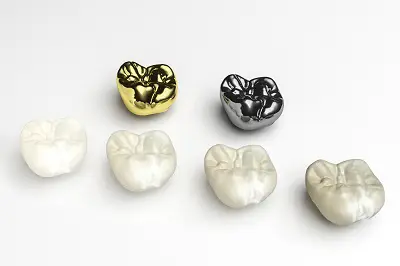Dental crowns are permanent replacements for severely damaged teeth. They help restore both the structural and functional integrity of decayed, chipped, or broken teeth. Crowns come in various materials, such as porcelain, ceramic, metal, or zirconia. Choosing the right prosthetic for your needs can boost your oral health and appearance, giving you a beautiful smile you can share with pride.

Choosing the Right Crown Material
Different materials have varying strengths. For instance, zirconia is more substantial than porcelain or ceramic. However, the toughest crown material may not necessarily be the best, and you need to keep other factors in mind, such as the appearance, cost, existing teeth color, etc. The pricing of crown materials varies. Gold, zirconia, and porcelain crowns are often more expensive compared to the other options. Porcelain-fused-to-metal and gold crowns are among the material types that will last longer. Others, such as all-porcelain and all-ceramic, are aesthetically appealing but may not be as durable under certain circumstances. The other factors that your dentist considers when determining crown materials include:- Gum tissue health
- Location and bite force on the affected tooth
- Color of the surrounding natural teeth
- The function of the tooth and whether it’s visible when you smile
- Materials used for other restorations you have
Top Choices for Crown Material
Now that you know what to look for before choosing a crown material, below are some popular options. Gold crowns are strong and can withstand chips, fractures, and corrosion, and are best used to restore molars and premolars. However, this material has poor esthetics due to its silver-yellowish color, making it distinct from the natural teeth and highly visible when you smile. They are also costly and may not be best for people with metal allergies to gold alloys such as palladium or chromium. All-ceramic or all-porcelain crowns are ideal for the front teeth, thanks to their natural appearance and strength. However, the thickness necessary to maintain that strength requires more tooth structure to be removed. They do not contain metal, which is essential if you have metal allergies. Porcelain-fused-to-metal is a solid material suitable for both the front and back teeth. They are robust, durable, and aesthetically appealing when correctly matched to the color of the surrounding teeth. The disadvantage with this material is that a dark metal line may show up at the gum line after a couple of years. Zirconia is one of the newest and strongest crown materials in the market, and for this reason, it has gained wider acceptance. Those looking for a durable crown material that will last decades should consider this option. The strength of the material means only a minimal amount of tooth structure has to be removed. The only downside is that this material is opaque while the natural enamel is translucent, so it may not be as natural-looking as you would like.Discuss Your Options with a Professional
Choosing the best crown material takes the skills and first-hand knowledge of a qualified dentist. Now that you understand the options, your dentist can help guide you on picking a material that matches your needs, personal taste, and budget.
The post How Important is Your Choice of Dental Crown Material? first appeared on Dental Signal.
